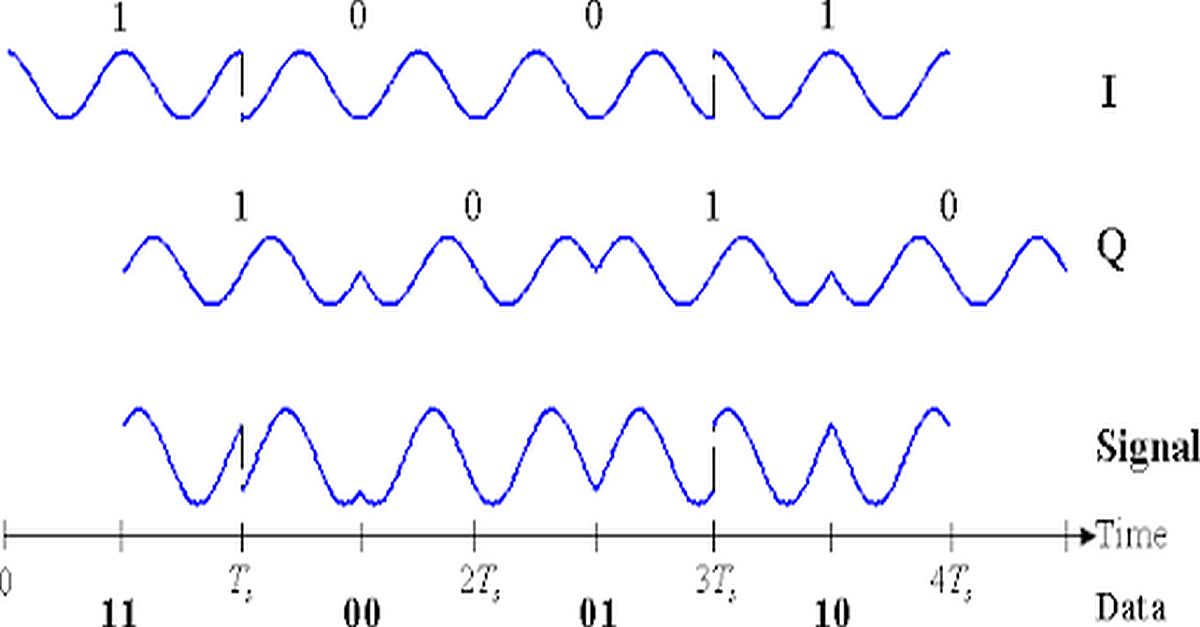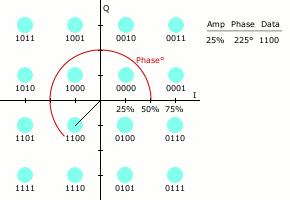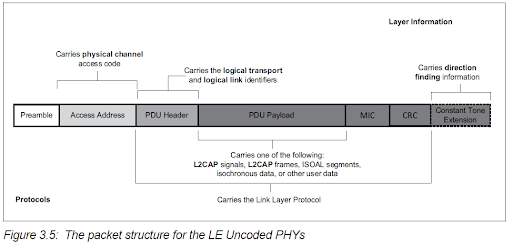It’s often entertaining to browse the sprawling Bluetooth Core Specification document, published by the Bluetooth SIG because, while complex, it is well written and provides insight to why things are the way they are in Bluetooth technology.
The PHY
At the lowest level of the Bluetooth core system architecture is the physical layer (“PHY”) where the actual fun of making very precise wireless signals occurs. Of interest to us here are the two different modulation schemes selected for creating digital signals in the unlicensed Industrial Medical Scientific (ISM) frequency band used for Bluetooth transmissions.
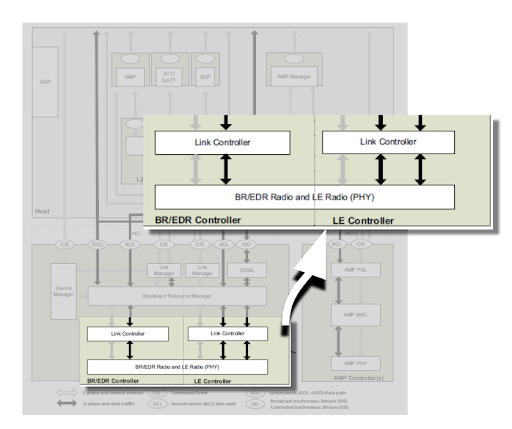
Worth noting, the ISM band is used by Wi-Fi devices, microwave ovens, medical diathermy (deep heat) machines, cordless phones, garage door openers, and baby monitors, among other devices. You may have noticed that running your microwave oven (transmit frequency 2.45GHz) may disrupt your connection to your Bluetooth music device (also 2.45GHz). It can be a wild and wooly spectrum.
Gaussian Frequency-shift keying (GFSK)
Prior to Bluetooth version 2.0, all of its transmissions used Gaussian Frequency-shift keying (GFSK), a frequency modulation scheme in which digital information is transmitted through discrete frequency changes of a carrier signal.
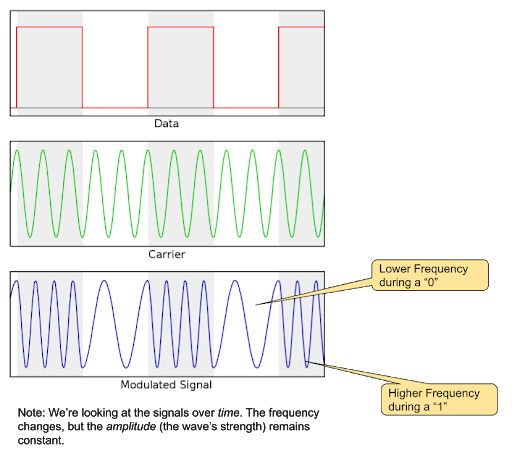
Frequency-shift keying has been in use for decades and interestingly, was used in 1941 for an innovative voice encryption system called SIGSALY. The addition of a Gaussian filter to the Frequency-shift keying actually shapes and smooths the modulated signal so the waveform isn’t slamming back and forth between the higher frequency (representing a digital “1”) and the lower frequency (representing a digital “0”).
This has the benefit of not “splattering” signals across adjacent frequencies and allows lower cost (less precision) transmission components to be used because the circuit doesn’t need to perform extensive out-of-channel filtering.
Gaussian filtering is a clever technique that is also used to “blur” or “smooth” images.
Now things are modern, since 2004
With Bluetooth version 2.0 the symbol rate is still 1Msymbol/second, but now using the Extended Data Rate the throughput is doubled to 2mbit/sec…but how?
Meet our new modulation friend π/4 Rotated Differential Quaternary Phase Shift Keying (DQPSK). It conveys data by modulating the phase of a constant frequency reference signal (the carrier wave) by varying the sine and cosine inputs at a very, very, very precise time. “Quaternary” refers to the fact that there are four possible phase positions for each symbol.
The waveforms for this modulation scheme look messy in this format, but. . .
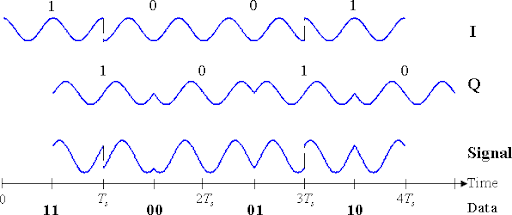
What if we cleverly assign two-bit combinations to each of the
four phases: 00, 01, 11, and 10 and use Gray code to minimize errors?
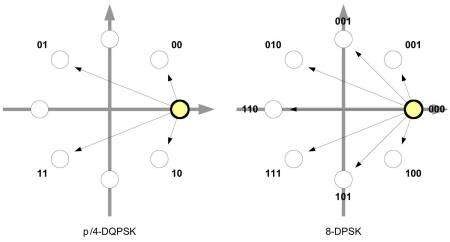 Wouldn’t we double the bit rate, without changing the symbol rate?
Wouldn’t we double the bit rate, without changing the symbol rate?
Wouldn’t we save battery power by transmitting more bits, faster?
YES to both!
The Gray code assures there’s only one bit difference between the combinations, reducing the change of a two-bit error in demodulation.
It’s an insanely clever technique. Just sling the phase to the quadrant you need and win two bits!
Other applications (broadcast HD TV, HD Radio, telecom) have expanded on this to transmit many bits at a time.
As a more complex example (not used in Bluetooth technology) this is a model showing four bits at a time, using both phase and amplitude, based on 16 symbols.
This is where Bluetooth technology gets a little weird with Extended Data Rate
Bluetooth mandates a 100% backward compatibility. This is a very good thing. The Bluetooth earpiece for the car that you bought in the ‘90s will still work.
Below is the 1M PHY scheme from the Bluetooth Core document. Our very old friend GFSK, is used to transmit Access Code, Header, and Payload. Nothing new here, it’s as old as the ‘80s music scene.

But here the Access Code and Header are sent in GFSK modulation (as usual), there’s a brief pause, and the 2M payload is transmitted in a completely different (DQPSK) modulation scheme! Note that this is the “Classic” Bluetooth transmission standard.
The GUARD period ensures that the two distinct modulation schemes GFSK and DQPSK do not interfere with each other (otherwise cause overlapping transmissions). It’s figuratively a “time out”, a palate cleanser, a deep breath, etc.

Freaky, but effective!
Bluetooth Low Energy transmissions, however, don’t need to change modulation schemes in mid-packet because it’s modern; the LE 1M PHY uses the familiar Gaussian Frequency-shift keying (GFSK) modulation, and the LE 2M PHY uses the more exotic π/4 Rotated Differential Quaternary Phase Shift Keying (DQPSK) modulation scheme. But the whole packet is transmitted in the same modulation.
Summary
Thanks for indulging in a little modulation science as we looked ever-so-briefly at Bluetooth modulation techniques. I am frequently in awe of the thought-power brought to bear on this technology, just so I can listen to music in a convenient way or more importantly, let Vulnerable Road Users be detected by vehicles in the roadway.
References
Figure 2.1, Bluetooth core system architecture, Bluetooth Core Specification, revision v5.2; 2019
Gast, Matthew; 802.11 Wireless Networks: The Definitive Guide, Second Edition; O’Reilly, 2003, excerpt at Flylib
McCall, David; Taking a Walk Inside Bluetooth EDR; EE Times; 2004
Wikipedia; Frequency-shift keying; undated
Wikipedia; Modem; undated
Wireless Pi; I/Q Signals 101: Neither Complex Nor Complicated; undated
Keim, Robert Understanding Quadrature Phase Shift Keying (QPSK) Modulation; All About Circuits; 2016
Keim, Robert Learning About Differential Quadrature Phase Shift Keying (DQPSK) Modulation; All About Circuits; 2016
Stroud, Ernest T. 𝝅/4 DQPSK ENCODER AND MODULATOR, Patent, 2002
Watts, Chris QUAM16 Demonstration, animated GIF; 2011

